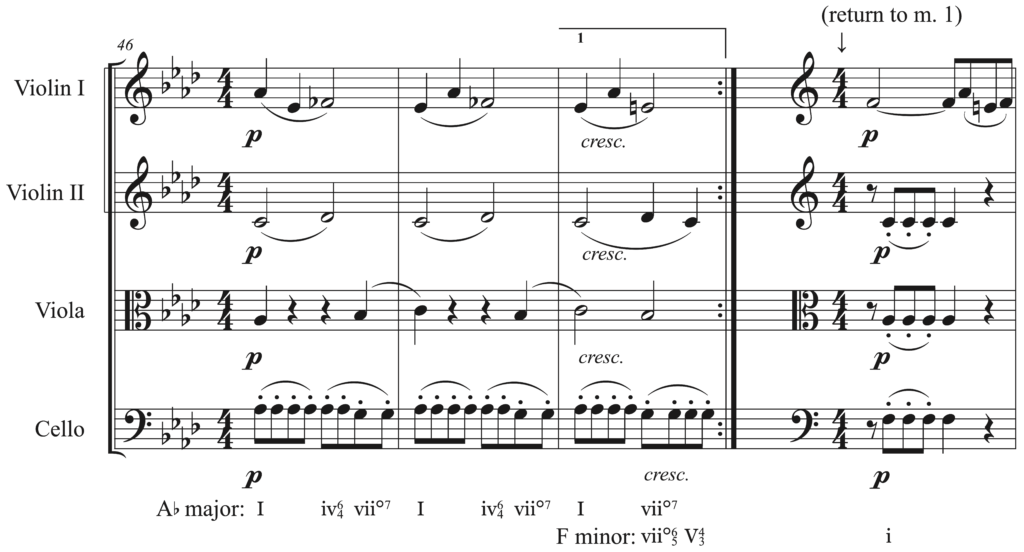Main Body
46 The “flatting” process
Learning goals for Chapter 46
In this chapter, we will learn:
- How to create a by lowering one note from any
- How the flatting process functions as a means of modulation in musical contexts
The “flatting” process as a means of modulation
You can create a new by lowering (“flatting”) any member of a by a . The lowered (or “flatted”) note becomes the root of the new dominant chord. Composers will use this technique to modulate to a new key; the newly created dominant seventh becomes the dominant of the new key. Video T88 walks you through the “flatting” process.
Video: T88 “Flatting process” video 1: intro (6:05)
In this video, we learn about how to create a new dominant (V7) by lowering any member of a fully diminished seventh chord. The lowered note becomes the root of the new dominant.
Example 46‑1 contains an excerpt from the first movement of Haydn’s String Quartet op. 20, no. 5, which illustrates this process. The “flatted” note appears in the second violin at the end of m. 48 (D![]() is lowered to C), enacting the modulation back to F minor as the piece returns to m. 1 after the first repeat sign in m. 48. This excerpt also features borrowed chords (iv
is lowered to C), enacting the modulation back to F minor as the piece returns to m. 1 after the first repeat sign in m. 48. This excerpt also features borrowed chords (iv![]() and viio7). Video T89 walks you through an analysis of this excerpt.
and viio7). Video T89 walks you through an analysis of this excerpt.
Example 46‑1. Franz Joseph Haydn, String Quartet op. 20, no. 5, mvt. 1, mm. 46–48 returning to m. 1

Listen to the full track, performed by the Aeolian String Quartet, on Spotify.
Learn about Austrian composer Franz Joseph Haydn (1732–1809) by reading this Oxford Music Online article, written by Georg Feder and James Webster.
Video: T89 “Flatting process” video 2: analysis (2:16)
This video explores how Haydn uses the flatting process (lowering a note from the viio7 to create a new dominant) to modulate from A![]() major to F minor in Example 46‑1.
major to F minor in Example 46‑1.
EXERCISE 46-1 “Lower the ____”
SET 1. First, identify the following:
- What is the root of the given chord on the staff below?
- What is the quality of the given chord?
- What key would the given chord tonicize?
Second, on a separate sheet of staff paper, lower the given specified member of the chord (root, third, fifth, or seventh) by a half step and respell the chord as needed to create a new dominant seventh in a stack of thirds. Then identify the new root, new Roman numeral symbol with figured bass, and new implied key.
SET 2. First, identify the following:
- What is the root of the given chord on the staff below?
- What is the quality of the given chord?
- What key would the given chord tonicize?
Second, on a separate sheet of staff paper, lower the given specified member of the chord (root, third, fifth, or seventh) by a half step and respell the chord as needed to create a new dominant seventh in a stack of thirds. Then identify the new root, new Roman numeral symbol with figured bass, and new implied key.
major-minor seventh chord built on scale degree 5; spelled as a major triad with minor seventh between root and seventh
seventh chord spelled as a diminished triad with diminished seventh between root and seventh, forming a stack of all minor thirds
a minor second (mi2) that is spelled with two successive letter names, for example, C-sharp and D


